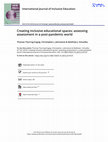Papers by Christopher Johnstone
International Journal of Educational Development, 2023
This article presents the adaptation of a screening tool to help young persons with disabilities ... more This article presents the adaptation of a screening tool to help young persons with disabilities understand what they may need to do in in order to move closer to meaningful work. Using critical capabilities approach, we developed a toolkit to support the transition process from home, school, or other setting to formal or informal employment in Bhutan. Community Inclusion Coordinators were recruited to mentor 40 participants to gain confidence, appropriate work skills to get closer to being work-ready. We also evaluated the efficacy and utility of the toolkit which revealed that some of the participants valued having honest and open conversations about personal and professional issues.

International Journal of Inclusive Education, 2023
This article traces the shutdown of large-scale assessment in two
countries – the United States a... more This article traces the shutdown of large-scale assessment in two
countries – the United States and Denmark – as a result of the
COVID-19 pandemic. These two countries, which have
complicated histories with large-scale assessment and inclusion
of diverse students, were forced to adjust their testing agendas
during 2020. This article seeks to explore what divergent and
convergent pathways Denmark and the United States could take
in regard to large-scale assessment, particularly in regard to
educational inclusion and diversity. Large-scale assessment
regimes at once delimit the imaginary of inclusion and actively
promote segregation and ability-based tracking, but at the same
time represent a space for conceptual inclusion in educational
achievement. Given these complexities, we provide policy
scenarios on assessments in a post-pandemic world that could
hold the potential of transcending the paradoxes presented by
the alignment of the elitist educational agendas of assessments
on the one hand, and the agenda of inclusion on the other hand.
To do so, we chronicle this recent history and then evaluate four
future scenarios for the two countries through the lens of
educational values and complex systems theory.

Comparative Education Review, 2023
Disability-inclusive education and development have become priorities for global governance organ... more Disability-inclusive education and development have become priorities for global governance organizations over the past decade and have thus introduced new complexities to existing development narratives. One reason for this is the long-standing discourse of "disability models" (medical, social, and cultural models) most often found in disability studies discourses. This study demonstrates that individuals with disabilities and their advocates navigate education and development opportunities through the lens of multiple models simultaneously. In this article, we introduce the philosophical theory of dialectics as a way of understanding how seemingly competing models might simultaneously inform the actions that individuals take in relation to disability-inclusive education and development. We present three minicases-two from teachers and one from a youth with a disability-drawn from a recent 3-year project in Bhutan. These case examples demonstrate how dialectical thinking is often present in education and development initiatives.

American Journal of Evaluation, 2023
This article reports on ways in which United Nations human rights treaties can be used as a norma... more This article reports on ways in which United Nations human rights treaties can be used as a normative framework for evaluating program outcomes. In this article, we conceptualize a human rights-based approach to program evaluation and locate this approach within the broader evaluation literature. The article describes how a rights-based framework can be used as an aspirational set of indicators for program evaluations to promote activities that align with internationally agreed-upon human rights norms. We then describe a case study of the evaluation through which this method was developed, including its sampling design, methodology, and findings. The United Nations International Children's Fund (UNICEF) inclusive education evaluation described highlighted the need for conceptual clarity around what inclusive education is, and the importance of contextualized innovation toward meeting the educational rights of children with disabilities. Human rights perspectives and evaluation designs can help create such clarity, but should also be used with care. Keywords convention on the rights of persons with disabilities, disability, evaluation, human rights, inclusive education, United Nations The contemporary conceptualization of human rights in diplomatic and programmatic discourses began gaining popularity after the creation of the United Nations and the subsequent 1948 Universal Declaration of Human Rights (UDHR). The 30 universal rights spelled out in the Declaration include life, rights to liberty, security, movement, nationality, opportunity to marry,
Disability as Diversity in India: Theory, Practice, and Lived Experience., 2024
This is the final chapter of the book "Disability as Diversity in India: Theory, Practice, and Li... more This is the final chapter of the book "Disability as Diversity in India: Theory, Practice, and Lived Experience." The chapter summarizes the work and begins to theorize directions in Disability Studies in India, drawing upon Bourdieu's concepts of "Field" and "Habitus."

An updated state guide to universally designed assessments (NCEO Report 431)., 2022
This Guide is an update to the State Guide to Universally Designed Assessments produced by
the Na... more This Guide is an update to the State Guide to Universally Designed Assessments produced by
the National Center on Educational Outcomes (NCEO) in 2006 (Johnstone et al.). It provides
a brief overview of what a universally designed assessment is, followed by a set of steps for
states to consider when designing and developing, or revising, their summative assessments. The
focus of this Guide is states’ summative assessments—general content assessments of reading/
language arts, mathematics, science, and other content; alternate assessments based on alternate
academic achievement standards (AA-AAAS); English language proficiency (ELP) assessments;
and alternate-ELP assessments. The purpose of this Guide is to provide states with strategies for
designing tests from the very beginning. The objective is to create tests that present an accurate
measure of the knowledge and skills of diverse student populations.
This Guide describes nine steps designed to improve accessibility of summative assessments:
1. Plan for Universal Design from the Start
2. Define Test Purpose and Approach
3. Require Universal Design in Assessment RFPs
4. Address Universal Design During Item Development
5. Include Universal Design Expertise in Review Teams
6. Perform Usability and Accessibility Testing
7. Implement Item and Test Tryouts
8. Conduct Item- and Test-Level Analyses and Act on Results
9. Monitor Test Implementation and Revise as Needed
Interventions with Impact: Community Inclusion Coordinators in Bhutan

Assessment of Inclusion in Higher Education: Promoting Equity and Social Justice in Assessment, 2022
Accommodations and accessibility are two primary mechanisms for promoting inclusion in higher edu... more Accommodations and accessibility are two primary mechanisms for promoting inclusion in higher education assessment. Assessment accommodations are a series of individually allowable changes to assessments (e.g., in their timing, allowable inputs/responses by students, location, etc.). The use of accessibility features for assessment, on the other hand, is informed by the concept of Universal Design for Assessment (UDA) and generally allows all students to engage with material in flexible ways in terms of timing, inputs/responses, location, and choice of activities. The principles of UDA are applied to assessments at the discretion of individual instructors. Both accommodations and accessibility promote inclusive higher education assessment, but both are limited in their scope. In this chapter, we make two arguments. First, instructors should have greater freedom to provide accommodations (while upholding those required by their university and national policy/law). The legal provision of accommodations is critical for the human rights of students with disabilities, but accommodations could also be extended to other students. Second, UDA is a powerful strategy for making assessment more inclusive of diverse participants in higher education classrooms, but its impact could be strengthened if it was institutionalized in instructor training and feedback.
International Social Work, 2021
This study reports on findings from 25 semi-structured, individual interviews with participants w... more This study reports on findings from 25 semi-structured, individual interviews with participants with visual, hearing, or mobility disabilities in India focusing on stigmatization and resilience, and how they are constructed within Indian sociocultural contexts. Participants' experiences of disability and stigmatization were alleviated or exacerbated by sociocultural issues, including socioeconomic status, caste, and gender hierarchy. A lack of family support and access to education further reinforced stigmatization. The case from India underscores the importance of addressing these intersectional issues, as well as stigmatization and resilience, to comprehensively support individuals with disabilities. Implications for practice, disability policies, theories, and research are discussed.

Journal of International Students, 2021
As more universities internationalize, interest in engagement between international and domestic ... more As more universities internationalize, interest in engagement between international and domestic students has increased. University initiatives to bring students together often adopt a deficit approach dependent on international students' adjustment to the host culture, overlooking the need for engagement to be a two-way exchange and the role of the institution in this process. Focusing on academic group work as a salient site of cross-national interaction, this study draws on analysis of focus group data to explore how institutional habitus or unwritten rules are enacted at a large U.S. university. Findings indicated that domestic students were better socialized to understand the habitus of the institution and tended to take charge in group work. In contrast, international students were seen as linguistically and academically deficient and were relegated to passive roles in a group. Important implications for practitioners and scholars of U.S. higher education are discussed.
Journal of International Development, 2022
This article aims to conceptualize contemporary understandings of ‘inclusive development’. The ar... more This article aims to conceptualize contemporary understandings of ‘inclusive development’. The article draws upon two conceptual models: plural/universal rights (Mégrét, 2008) and social/relational inclusion (Gupta & Vegelin, 2016) to demonstrate how ‘inclusion’ is understood concerning economic, social, and human development. The article then draws upon these disparate, yet interconnected understandings of inclusive development and maps four contemporary inclusive development approaches (participation of stakeholders, representational politics, social protection, and economic redistribution). The purpose of this mapping is to provide context for how the singular word ‘inclusion’ can be used to pursue multiple desired outcomes, some of which may conflict with one another.

Prospects: Quarterly Review of Comparative Education, 2022
This article examines the limitations of developing youth programs through solely a human capital... more This article examines the limitations of developing youth programs through solely a human capital framework. While there is undoubtedly a strong connection between skills development and potential economic opportunity, our findings reveal that the story of youth who manage to navigate difficult economic environments is complex and nuanced. The article interprets findings through a critical capabilities lens. Its findings indicate that, beyond skills, youth leveraged microcapital gifts from families, connected with each other and broader social networks for new opportunities, and supported one another emotionally. Participants' stories demonstrate that converting youth capabilities into functioning in their environment requires varied forms of support and networking beyond simple skills development. The article considers implications for youth development programs and research.

Comparative Education Review, 2022
Inclusive education is a core initiative of United Nations organizations and national governments... more Inclusive education is a core initiative of United Nations organizations and national governments around the world. In this article, we chronicle the development of a 2019 inclusive education policy in Lesotho by examining the role of organizations of persons with disabilities (DPOs) and their policy advocacy. A standpoint epistemological approach is used, relaying the direct experiences of DPO leaders. We frame these events through political settlement theory, which states that when there is a policy conflict, settlements are drawn between powerful actors (governments) and those advocating for change. This typically occurs when the political or economic price of ignoring or suppressing advocacy groups becomes too high for governments to bear. In this study, a DPO successfully advocated for a new policy through media campaigns, direct engagement of government officials, leveraging donor support, and arguing for accountability around international treaty commitments. The political settlement of DPO and government in Lesotho is instructive about new ways in which inclusive education policies are being developed in the wake of the Convention on the Rights of Persons with Disabilities and increased DPO activism.

Journal of Studies in International Education, 2022
This article reports on an ethnographically-informed case study of a Canadian university that is ... more This article reports on an ethnographically-informed case study of a Canadian university that is experiencing growth and systems change through three initiatives: internationalization, intercultural education, and Indigenization. The article describes the goals of internationalization and "interculturalization" (a term coined at the university) at the site of the case study. The study then examines points of convergence and tensions between internationalization and interculturalization and emerging Indigenization initiatives. The work draws upon conceptualizations of "imaginaries" in higher education, and identifies that plural imaginaries exist within a single institution, creating opportunities for convergence but also overreach by particular actors. We conclude that imaginaries are a useful conceptual tool for understanding the broad-based goals of higher education and identifying their varied rationales and also for understanding intra-institutional dynamics.
JTLA is a free online journal, published by the Technology and Assessment Study
Target audiences for this paper include researchers, cognitive scientists, instructional design a... more Target audiences for this paper include researchers, cognitive scientists, instructional design and technology experts, test developers, and practitioners. Researchers with expertise in the cognitive sciences will be needed to help increase understanding of cognitive pathways. Instructional design experts can help translate what is known about the cognitive pathways into learning progressions. Instructional technology experts can help design learning environments that maximize the effective implementation of learning progressions. Test ...
Disability Studies Quarterly, 2004
... are meant to be counter-hegemonic to delimiting views of people with disabilities and oppress... more ... are meant to be counter-hegemonic to delimiting views of people with disabilities and oppressive policies (Peters & Chimedza, 2000). ... Systems theorists like Margaret Wheatley call this "requisite variety," or the necessary diversity that humanity needs to understand itself and its ...
Journal of Special Education Leadership, 2006
Abstract: English language learners (ELLs) with disabilities are an emerging population in the US... more Abstract: English language learners (ELLs) with disabilities are an emerging population in the US and therefore command special attention in assessment systems. Research has demonstrated that" universal design of assessment" approaches are effective in helping to make assessments more accessible for ELLs with disabilities. Special education leaders can tap the expertise of teachers and ELLs with disabilities themselves as ways of improving assessment at the classroom and district levels.

Journal of Teaching and Learning
This study examines the motivations and experiences of international and domestic students on thr... more This study examines the motivations and experiences of international and domestic students on three U.S. campuses related to cross-national interactions within classroom settings. The study also examines the role of instructors in facilitating such interactions through individual and group interviews. Findings indicate that domestic students appreciate the global perspectives of international students related to course content. International students, in turn, appreciate the “real world” perspectives that domestic students provide about the US (but do not necessarily find value in their content-related comments). The implications of this study are that cross-national interactions have different meanings for different stakeholders (i.e., some perceive to benefit academically while others perceive to benefit culturally). The implications of this study relate to how instructors structure student interactions and what might be reasonable outcomes for students in international groups in ...
FIRE: Forum for International Research in Education, 6 (1), 1-7., 2020









Uploads
Papers by Christopher Johnstone
countries – the United States and Denmark – as a result of the
COVID-19 pandemic. These two countries, which have
complicated histories with large-scale assessment and inclusion
of diverse students, were forced to adjust their testing agendas
during 2020. This article seeks to explore what divergent and
convergent pathways Denmark and the United States could take
in regard to large-scale assessment, particularly in regard to
educational inclusion and diversity. Large-scale assessment
regimes at once delimit the imaginary of inclusion and actively
promote segregation and ability-based tracking, but at the same
time represent a space for conceptual inclusion in educational
achievement. Given these complexities, we provide policy
scenarios on assessments in a post-pandemic world that could
hold the potential of transcending the paradoxes presented by
the alignment of the elitist educational agendas of assessments
on the one hand, and the agenda of inclusion on the other hand.
To do so, we chronicle this recent history and then evaluate four
future scenarios for the two countries through the lens of
educational values and complex systems theory.
the National Center on Educational Outcomes (NCEO) in 2006 (Johnstone et al.). It provides
a brief overview of what a universally designed assessment is, followed by a set of steps for
states to consider when designing and developing, or revising, their summative assessments. The
focus of this Guide is states’ summative assessments—general content assessments of reading/
language arts, mathematics, science, and other content; alternate assessments based on alternate
academic achievement standards (AA-AAAS); English language proficiency (ELP) assessments;
and alternate-ELP assessments. The purpose of this Guide is to provide states with strategies for
designing tests from the very beginning. The objective is to create tests that present an accurate
measure of the knowledge and skills of diverse student populations.
This Guide describes nine steps designed to improve accessibility of summative assessments:
1. Plan for Universal Design from the Start
2. Define Test Purpose and Approach
3. Require Universal Design in Assessment RFPs
4. Address Universal Design During Item Development
5. Include Universal Design Expertise in Review Teams
6. Perform Usability and Accessibility Testing
7. Implement Item and Test Tryouts
8. Conduct Item- and Test-Level Analyses and Act on Results
9. Monitor Test Implementation and Revise as Needed
countries – the United States and Denmark – as a result of the
COVID-19 pandemic. These two countries, which have
complicated histories with large-scale assessment and inclusion
of diverse students, were forced to adjust their testing agendas
during 2020. This article seeks to explore what divergent and
convergent pathways Denmark and the United States could take
in regard to large-scale assessment, particularly in regard to
educational inclusion and diversity. Large-scale assessment
regimes at once delimit the imaginary of inclusion and actively
promote segregation and ability-based tracking, but at the same
time represent a space for conceptual inclusion in educational
achievement. Given these complexities, we provide policy
scenarios on assessments in a post-pandemic world that could
hold the potential of transcending the paradoxes presented by
the alignment of the elitist educational agendas of assessments
on the one hand, and the agenda of inclusion on the other hand.
To do so, we chronicle this recent history and then evaluate four
future scenarios for the two countries through the lens of
educational values and complex systems theory.
the National Center on Educational Outcomes (NCEO) in 2006 (Johnstone et al.). It provides
a brief overview of what a universally designed assessment is, followed by a set of steps for
states to consider when designing and developing, or revising, their summative assessments. The
focus of this Guide is states’ summative assessments—general content assessments of reading/
language arts, mathematics, science, and other content; alternate assessments based on alternate
academic achievement standards (AA-AAAS); English language proficiency (ELP) assessments;
and alternate-ELP assessments. The purpose of this Guide is to provide states with strategies for
designing tests from the very beginning. The objective is to create tests that present an accurate
measure of the knowledge and skills of diverse student populations.
This Guide describes nine steps designed to improve accessibility of summative assessments:
1. Plan for Universal Design from the Start
2. Define Test Purpose and Approach
3. Require Universal Design in Assessment RFPs
4. Address Universal Design During Item Development
5. Include Universal Design Expertise in Review Teams
6. Perform Usability and Accessibility Testing
7. Implement Item and Test Tryouts
8. Conduct Item- and Test-Level Analyses and Act on Results
9. Monitor Test Implementation and Revise as Needed